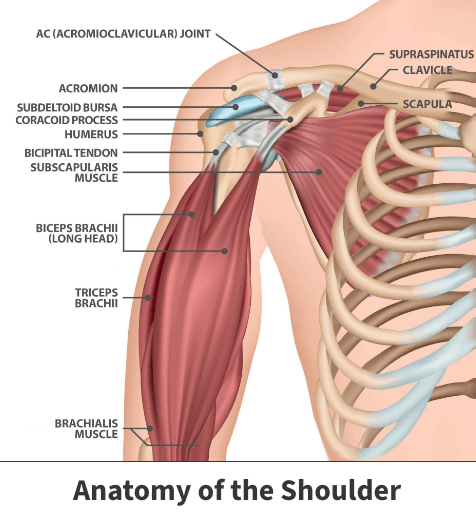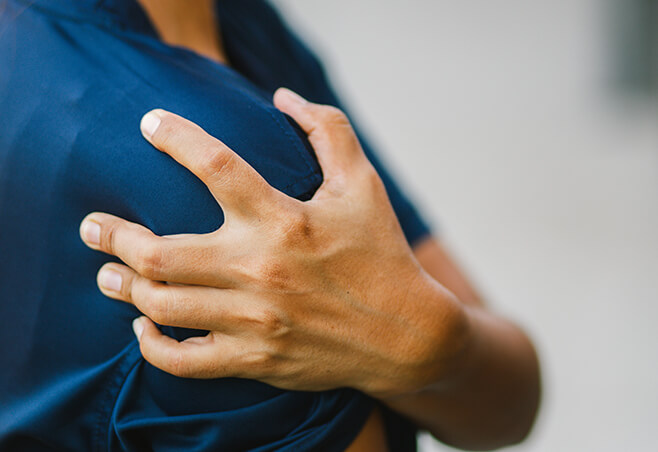Calcific tendinitis of the shoulder is a condition that causes the tendons in the shoulder, known as the rotator cuff, to become inflamed. Additionally, calcium deposits begin to build up, which are dense, bonelike structures. This condition typically appears in people between the ages of 40 and 60 and is caused by overusing the shoulder. There are both surgical and nonsurgical procedures available to help you get back to your daily routine.
Anatomy

Your shoulder is made up of three bones: your upper arm bone (humerus), your shoulder blade (scapula), and your collarbone (clavicle).
The head of your upper arm bone fits into a rounded socket, known as the glenoid, in your shoulder blade. A combination of muscles and tendons, known as the rotator cuff, keep your arm bone centered in your shoulder socket. The rotator cuff covers the head of your upper arm bone and attaches it to your shoulder blade.
Within the shoulder joint, there are small, fluid-filled sacs known as bursae (also called bursa). Their purpose is to provide a cushion between your joints, which helps reduce friction between the muscles and bones in the joint.
About
Calcific tendinitis of the shoulder is when calcium deposits build up in your shoulder muscles and tendons, also known as the rotator cuff. It is one of the most common causes of shoulder pain. You’re more likely to be affected if you perform a lot of overhead motions, such as heavy lifting, or play sports like basketball or tennis.
Other factors can also cause this condition, such as:
- Genetic predisposition
- Abnormal cell growth
- Abnormal thyroid gland activity
- Bodily production of anti-inflammatory agents
- Metabolic diseases, such as diabetes
This condition is typically seen in adults between 40 and 60 years old, and women generally are more likely to be affected than men.

Symptoms
When calcific tendinitis of the shoulder first begins, the symptoms are very mild and generally include:
- Minor pain that is present both with activity and when at rest
- Pain radiating from the front of the shoulder to the side of the arm
- Sudden pain when lifting or during reaching movements
- Athletes in overhead sports may have pain when throwing
As time passes and the injury worsens, the symptoms may worsen into:
- Pain at night
- Loss of strength and motion
- Difficulty doing activities that place the arm behind the back, like buttoning or zippering
Diagnosis
Your Florida Orthopaedic Institute physician will take a look at your symptoms, medical history, and overall health, followed by a physical examination. You may be asked to lift your arm or make arm circles to observe any limitation in your range of movement.
Your physician may recommend you take some tests to check for calcium deposits and that your symptoms are not caused by a different injury. X-rays are one of the most common tests to confirm calcific tendinitis of the shoulder because they show dense structures such as calcium deposits. An ultrasound is also a useful test as it can help your doctor locate any smaller deposits that the X-rays may have missed.
Treatment
There are both non-surgical and surgical treatments available to get you back to your daily activities. Nonsurgical treatments will be recommended to you first. If these treatment options do not work, then surgical treatment options will be considered.
Nonsurgical
There are several nonsurgical treatments available to help get you back on your feet as quickly as possible. These treatments include:
- Rest – Keep all weight off of your shoulder and avoid any strenuous movements to give the shoulder time to heal.
- Medications – Medications such as Advil/Motrin (ibuprofen), Aleve (naproxen), and aspirin work to reduce pain and swelling.
- Physical therapy – Physical therapy can restore normal motion to your shoulder. Stretching exercises to improve range of motion are very helpful in healing your injury.
- Steroid injection – If rest, medications, and physical therapy do not relieve your pain, an injection of a local anesthetic and a cortisone preparation may be helpful. Cortisone is a very effective anti-inflammatory medicine. Injecting it into the bursa beneath the acromion can relieve pain.
Surgical treatments
If nonsurgical treatments are unsuccessful, then you may need to get surgery. Typically, the surgical procedure will be performed arthroscopically and consists of creating more space for the rotator cuff. To do this, your surgeon will remove the inflamed part of the bursa.
Additionally, your surgeon may treat other conditions present in the shoulder at the time of surgery. These can include arthritis between the clavicle (collarbone) and the acromion (acromioclavicular arthritis), inflammation of the biceps tendon (biceps tendonitis), or a partial rotator cuff tear.
Videos
Related specialties
- AC Joint Injuries
- Atraumatic Shoulder Instability
- Bankart Repair
- Bicep Tenodesis
- Broken Collarbone
- Bursitis of the Shoulder (Subacromial Bursitis)
- Clavicle Fractures
- Dislocated Shoulder
- Fractures of the Shoulder Blade (Scapula)
- Glenoid Labrum Tear
- Impingement Syndrome of the Shoulder
- Little League Shoulder
- Reverse Total Shoulder Replacement
- Rheumatoid Arthritis (RA) of the Shoulder
- Rotator Cuff Tears
- Shoulder Arthritis
- Shoulder Arthroscopy
- Shoulder Injury: Pain in the Overhead Athlete
- Shoulder Replacement
- Shoulder Separations
- Shoulder Socket Fracture (Glenoid Fracture)
- SLAP Tears & Repairs
- Subacromial Decompression
- Trapezius Strain (Muscle Strain Of The Upper Back)
- Traumatic Shoulder Instability
